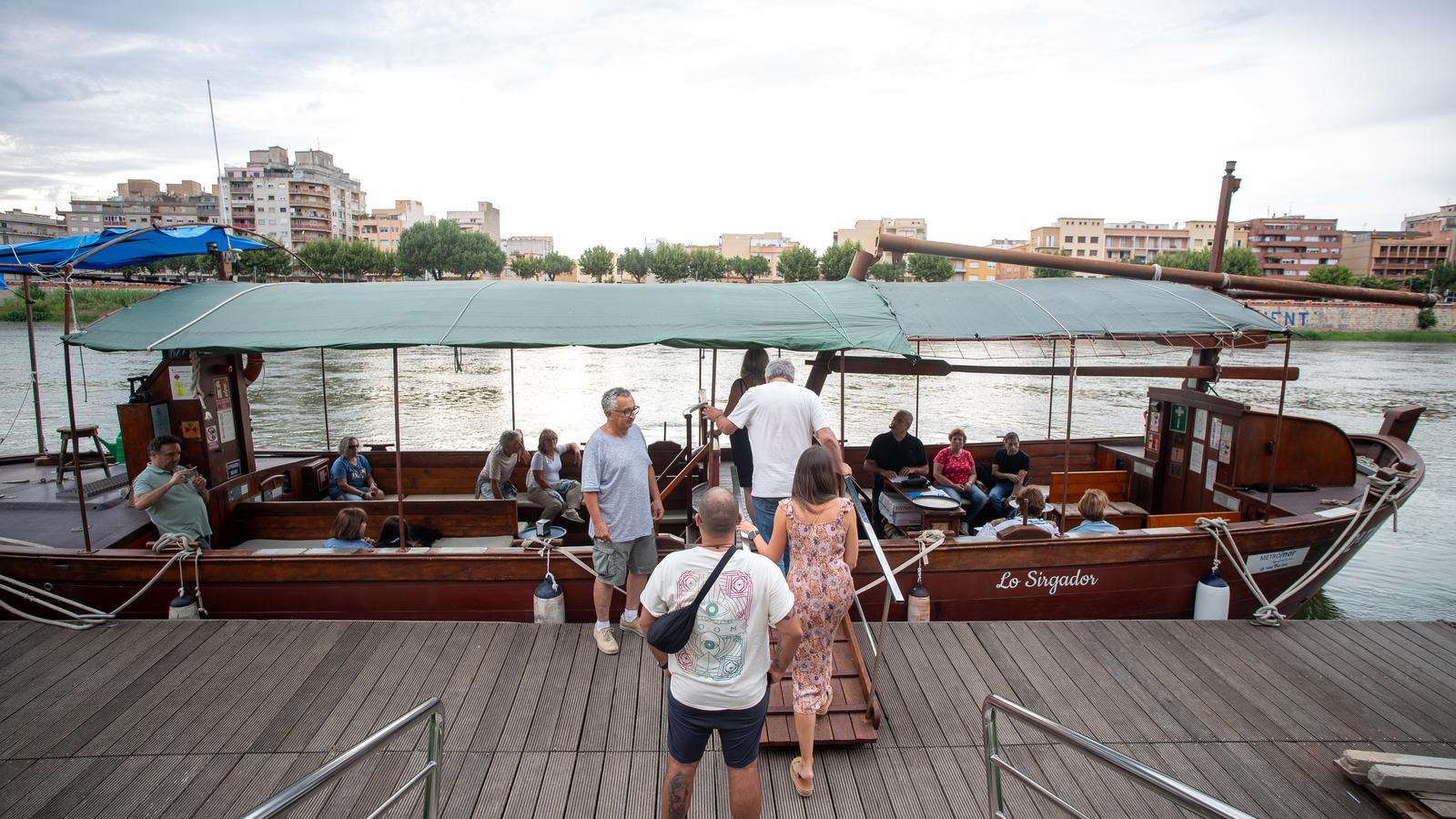Today I embark on The towman, a magnificent lute of rather large dimensions – 15 metres long and 4 metres wide – for around fifty passengers, which sets sail from Tortosa and makes a trip along the Ebro, first upstream and then downstream. The Towman It is usually found in the water, next to the Tortosa market (built at the end of the 19th century, in the modernist style, on land reclaimed from the Ebro).
The first thing that strikes me when I see the boat is that it has two registrations on the bow—indecipherable to me; I know few people outside of the industry who "understand" boat registrations—: the sea registration and the river registration. From Tortosa upstream, it's river, of course, and from Tortosa downstream, administratively, it's sea. Tortosa, then, has the dual status of a river and sea port.
"In the first few years, we went to Miravet a few times," Jordi Domingo explains to me as we set off. Together with Adelino Fontanet, he takes the reins—the helm, I mean—of The Towman"How long did it take you, from Tortosa to Miravet?" I ask. "About four hours," he replies. "And a little less on the way back?" "Yes." It's a descent, of course. The route passes through Xerta and we have to cross the dam. "We decided against offering this route due to a few problems, such as the lack of water and the obstacles they put in our way.In some stretches we touched bottom and on each trip we had to change the propellers: they became deformed and sometimes broke because they rubbed against stones in the river. They made us take the boat – which weighs 13 tons – out of the water to prove that there were no apple snail eggs, an invasive species that wreaks havoc on rice fields." In Tortosa, where it is moored The TowmanThere is a very strong current and neither Jordi nor Adelino have ever seen an apple snail stuck to the boat.
At the moment The Towman is dedicated to shorter routes, like the one I'm enjoying today. It also offers other "products," such as the trip to Isla de los Toros, when the sun sets, with cava and pastelito (a typical Tortosa sweet, filled with angel hair, in the shape of a half-moon, reminding us that the Arabs left their mark here), and also at midday, with vermouth. Regardless of the length, they say they are "cruises" as a marketing strategy, although they are far from those that take place on the Nile or other great rivers of the planet. But the enthusiasm and explanations of those responsible for The Towman probably exceed that of these large cruise ships.
"To the veterans who found glory in the Battle of the Ebro", I read as we pass by the controversial iron Francoist sculpture located in the middle of the river. It does not specify which side the ex-combatants are from, but the Republicans have never been honored. "The Battle of the Ebro was a massacre, decisive for the triumph of the nationals in the Civil War," Jordi recalls. "In Tortosa, 'we haven't missed' any of the wars that have taken place on the Peninsula in recent centuries." I suppose that one day or another this monument will be demolished. To make light of the controversy, Jordi says it's a tribute to beer. He finds details that symbolize some... of identifying them!
"Look! A turtle!" Adelino exclaims. I follow with my eyes what his index finger "says," but I don't see it. It's vanished. Most of the turtles around belong to people who keep them at home, get tired of them... and throw them into the river. Even wild boars have been seen. They're good swimmers.
We now stand next to the lush riparian forest of Xiquina Island, where vegetation and fauna take center stage. It reminds me of some areas of Costa Rica visited by boat, where nature is unrivaled. Seeing spaces like this makes it clear that humans are unnecessary for biodiversity. Yes, we're redundant. Remember the total lockdown caused by COVID-19, when vegetation and animals proved they didn't need us humans at all?
Jordi then shows me some magnificent "vintage" photographs—from many years ago, in black and white—which are passed around among all the travelers (except for one with a narrowed gaze who shakes his head). The image that most catches my attention is that of a floating bridge, made of boats, pedestrians, and carts, that crossed the Ebro. It was built in medieval times and operated until the end of the 19th century. It burned down several times. The last one was never rebuilt.
From the boat, we have good views of monumental Tortosa. The Suda (the castle located at the top of the hill overlooking the city) and the cathedral stand out. And on the other side (the Els Ports de Beceite) is the great Church of Roser, from the early 20th century. The old Church of Roser was located in the old city, near the cathedral, but it was demolished to make way for a ramp for one of the bridges that crosses the Ebro. If it hadn't collapsed, cars coming from the bridge would now drive directly onto the main altar.
Built to regularly transport passengers across the river
The Sirgador was built in 2009 in La Ràpita at the request of the Baix Ebre Regional Council to regularly connect the different towns along the river, from Tortosa to Miravet. But the initiative failed. "The project was too ambitious. There weren't enough passengers," says Jordi Domingo.
In addition to its "small cruises," Lo Sirgador participates in numerous cultural events in Tortosa. It also organizes weddings on board and all kinds of celebrations, sailing, as well as school trips and outings for children, including dramatized ones featuring the pirate Cóc del Ràpid.


